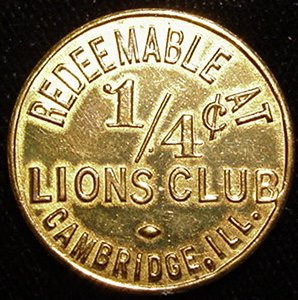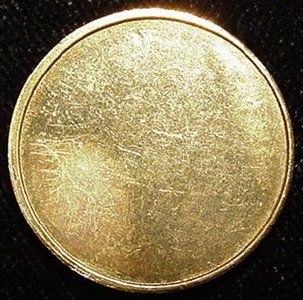Let’s begin a new series of photos, exploring some of the many different Illinois provisional sales tax tokens.
Our hope is that this series, over time, will help serve as a resource for the new collector. As well, these photos may help remind some of the seasoned collectors about a time in their own history when these “common” tokens seemed elusive.
If you’ve got a story connected to a specific token that we post a photo of, please feel free to take advantage of the “reply” section and tell us your tale, no matter how mundane it may seem to you!
To begin, let’s take a look at the Cambridge provisional token. Listed in the M&D book as number “L8”, it was redeemable at the Lion’s Club, worth a quarter of a cent at the time, had a rarity rating of R3 at the time of the M&D book and is made from copper.









Thanks for the story, John. I grew up in Maryville, Missouri, not too far from Kansas City. Your story duplicates my own in many regards, and it was fun to hear. Thanks again. Monte
Well, Monte asked for me to tell my personal story “about using sales tax tokens.” I have told this many time before and will again now.
Going back to the mid 50’s when I was six to ten years old, my mother worked and so during in the summer my grandmother took care of me during the day. We lived in Kansas City and the red one mill and green five mill plastic tokens were still being used. As a kid I liked them but most adults thought they were a nuisance.
My grandparents lived in an old fashion big family house with six bedrooms. All the kids were grown and had moved on so they rented out the rooms. Boarders, neighbors and relatives were coming and going all day. It was pretty exciting as a young fellow especially since many of the boarders were from Europe.
My grandmother did the laundry for most of the boarders and took in laundry from other. This was before everything was “wash and wear” and “perma-press.” So after the washing, cloths were then put through the wringer and hung on a line to dry. Then my grandmother would have to press the cloths with a hot electric iron. If a plastic tax token stayed in a pocket through this process, the hot iron would cause the plastic token to create a “permanent” impression of the token in the cloth. Whenever this happened my grandmother would say a few words in German in frustration. I didn’t know the translation of the German words but when I repeated them in front of my mother I got my mouth washed out with soap!
So my grandmother assigned me to checking all pockets before the wash and I got to keep what I found! All I ever found was plastic tax tokens. In those days there was still a corner grocery in the neighborhood. I liked to walk to the grocery with anybody that was going and I had a reputation of being very good at begging for a Popsicle. With the assignment as “pocket inspector” I had “money” of my own for a popsicles but it was slow to accumulate. So I started asking for adults to give me their tax tokens went they entered the house. It didn’t occur to me until many years later that my grandmother didn’t to everybody’s laundry and that some adults kept tax token for their own usage. But I was successful at gathering 70 mills per week for Popsicles. As a matter of fact, my first solo walk to the corner grocery was with 70 mills for a Popsicle. I still remember the trip because it was the first time I conducted a retail transaction on my own.
I still like Popsicles but I don’t buy them with tax tokens anymore. Good Times! Good Memories!
My father told me that when he was younger, he and the other neighborhood boys would collect the tokens (in Missouri) and that there were a couple of small grocery stores that would allow them to buy penny candy with the mills.
Hey John, and All,
We would love to hear more details about your experience with sales tax token use when they were still in circulation. What state? What time period? Details you mentioned about buying a popsicle, etc. In fact, you might be able to work that knowledge into an article for the ATTS Newsletter. Mike would be very happy to edit such a neat article for the newsletter, I am sure. Monte
Determiming the legal statis of the sales tax tokens or scrip in the states that issued them can be somewhat daunting unless you are prepared to wade into history for those specific details. I cannot think of any state that did not specifically list the tokens in their own laws in such a way as to prevent STT’s from ever being used as actual monetary currency. If you’ve read some of the history in 1933 when Illinois especially, and Washington less so - had such trouble with the Federal government about the issue and use of sales tax tokens. That conflict governed the decisions of the other states that followed after 1933 in adopting some form of token or scrip, as they did not want to get in a “fight” with the U.S. Treasury.
But there are many individuals who have reported, as you did, that they used sales tax tokens as currency with an exchange value as if they were “real money”. Les Albright and Jim Calvert both related similar stories of using tokens during their circulation as “money” in Washington. There have certainly been other reports, too, although those are the only two that pop up in my head at the moment.
There has always been some debate (sometimes almost downright fighting), about if the sales tax token was a legal tender coin since they were issued by state governments. The point of contention, of course, is the legality of doing so. We have many reports of STT’s being used as money to buy product rather than only as use for sales tax payments. So if you determine the answer strictly by actual use - then they could be considered legal tender. BUT - and this is the BIG BUT - since all the states CTA’ed (covered their a…es), by insuring the laws implemented for sales tax tokens specifically denied their legal use as exchange value items, that side of the debate would win the contest as by law, none of them were legal tender.
So how an STT was used, and the laws that governed their use, were sometimes opposed. For our purposes, it really doesn’t matter. Those that WANT the state issued STT’s to be considered “real state issued money” are almost always those who have tons of them and believe (rightly) that if STT’s were all of a sudden listed in the Red Book (which is an extreme example, of course) there would be millions of new collectors overnight.
Those that oppose that view and give tons of evidence showing the laws governining the STT issues were not legally sanctioned as legal tender usually don’t have a dog in the fight. They are simply going by the “letter of the law”.
This battle is usually only discussed as it regards state issued tokens, as the private, local, provisional, and merchant tokens and scrip that were meant to be used for partial cent payment to help their customers, but were totally outside the legislative process. Some states encouraged these private entities to issue their own tokens and scrip, while other states specifically forbade such use. Although there is much less contention concerning those issues, as they were not made via a strict legislative process resulting in a state wide law, there are few who would proclaim those tokens and scrip as legally sanctioned.
Good point on “How it was used is the determining factor…” if a token is a sales tax token or not. And in some case maybe we should say the “intended” or “legal” usage. I know that it was not intended and/or legal in many places to used sales take tokens for purchasing merchandise in a store. But as a 7 year old (many years ago), I remember rounding up 50 to 70 tokens from adults and going to the corner grocery store and buy a popsicle. Good Time! Good Memories! and one of my reasons for collecting.
Please note that this token does not say anything at all about sales tax, but it is known from historical documentation of the time that it was used for that purpose. In fact, if you look at the number of tokens produced in Illinois as private or provisional issues, you will see that MANY of them do not mention anything at all about tax, or sales tax.
This has led to some difficulties in the past, as such tokens as the 1/4 cent produced for Avon, Illinois was very similar to sales tax tokens, but was produced BEFORE sales tax was implemented in that state.
Since so many tokens were produced with what might appear as a “sales tax token denomination” (1/5, 1/3, 1/4 cent), but were actually not sales tax tokens, it is important to remember that the denomination on a token neither includes or excludes it as a sales tax token. How it was used is the determining factor, and for those that are considered sales tax tokens all or part of the payment made when exchanged had to be for sales tax.
This is not just a “problem” for Illinois. A number of other states also had merchant, private, and provisional tokens in “sales tax like” denominations that did not list tax or sales tax on the tokens. In all cases when a determination is made as to if a token was indeed used to pay part or all of it’s value for sales tax, the confirmed historical information we have determines that classification.
In some cases, as with one token from Indiana, several from Pennsylvania, and one from Ohio (off the top of my head) the denomination and time produced and the merchant business would all indicate a probable use of those pieces to pay for sales tax, but absolute confirmation has never been discovered. In those instances, until we do know definitively, it is best to list them as possibilities with the caveat that we have not established historical certainty.
In conclusion, not having the magic words “sales tax” on a token does not preclude it from having been used for that purpose.